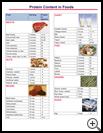
Protein in the Diet
________________________________________________________________________
KEY POINTS
- Your child’s body uses protein to build and repair skin, muscles, and organs.
- The amount of protein your child needs to eat depends on your child’s age, gender, and level of physical activity.
- The healthiest diets include a variety of foods. Choose carefully which proteins your child eats. Eating too much meat can lead to high cholesterol or other problems. A diet that is too high in protein can put a strain on your child’s kidneys.
________________________________________________________________________
What is protein?
Proteins are a kind of building block found in every cell of the body. Your child’s body uses protein to build and repair skin, muscles, and organs. Protein is found in foods such as meats, poultry, fish, beans, soy products, nuts, and seeds. You can tell how much protein is in a food by reading the nutrition facts food label.
How much protein does my child need?
The amount of protein your child needs to eat depends on your child’s age, gender, and level of physical activity.
Children
- 2 to 3 years old - 2 ounces**
- 4 to 8 years old - 4 ounces**
Girls
- 9 to 13 years old - 5 ounces**
- 14 to 18 years old- 5 ounces**
Boys
- 9 to 13 years old - 5 ounces**
- 14 to 18 years old - 6 1/2 ounces**
**An ounce in this list is equal to:
- 1 ounce of meat, poultry or fish
- 1/4 cup cooked beans
- 1 egg
- 1 tablespoon of peanut butter
- 1/2 ounce of nuts or seeds
As a general rule, your child should get 10% to 35% of total daily calories from protein.
How do proteins fit into a weight-loss program?
Eating a very high-protein, low-carbohydrate diet may lead to faster weight loss than a balanced diet that includes a variety of foods. However, very high protein diets often lack important nutrients and fiber, and they can be high in unhealthy fats. These diets can also be hard to follow for a long time.
The healthiest weight loss diets include a variety of foods with a focus on low-calorie, less processed, high-fiber foods with low amounts of saturated fat.
How can my child eat the right proteins?
It is important to choose carefully which proteins your child eats. Eating too much meat can lead to high cholesterol levels. A high-protein diet can also put a strain on your child’s kidneys.
Here are some ideas for getting enough protein without getting too much fat:
- Buy only lean cuts of meat, such as chicken or turkey breast without skin; pork tenderloin; flank, round, or sirloin beef; and low-sodium ham.
- Let your child snack on nuts and seeds such as raw almonds, hazelnuts, walnuts, sunflower seeds, or pumpkin seeds. Be careful that your child doesn’t eat too many, because nuts and seeds are high in fat.
- Try soy products such as tofu, tempeh, and soy milk.
- Cook lean. Bake, broil, grill, steam, or microwave meats instead of frying them.
- If your family eats a lot of meat, cut back at each meal for several days. The goal is to limit meat to 2 servings per day, with each serving being about 3 to 4 ounces, which is the size of a deck of cards or the palm of your hand.
- Serve 2 or more meals each week that do not include meat. Increase servings of vegetables, rice, pasta, and beans in all meals. Try casseroles, pasta, and stir-fry dishes that have less meat and more vegetables, grains, and beans.
- Eat broiled or grilled fish, such as salmon or tuna, at least 2 times a week.
- Fast food can be very high in total fat, saturated fat, and trans fat. If your child eats fast food, choose grilled chicken or a salad with fat-free or low-fat dressing. Ask for nutrition information from fast-food restaurants so that your child can choose wisely.
For more information check with:
- The Academy of Nutrition and Dietetics
800-366-1655
http://www.eatright.org - Dietary Guidelines for Americans
https://www.cnpp.usda.gov/dietary-guidelines
Last modified: 2016-10-18
Last reviewed: 2017-05-18

